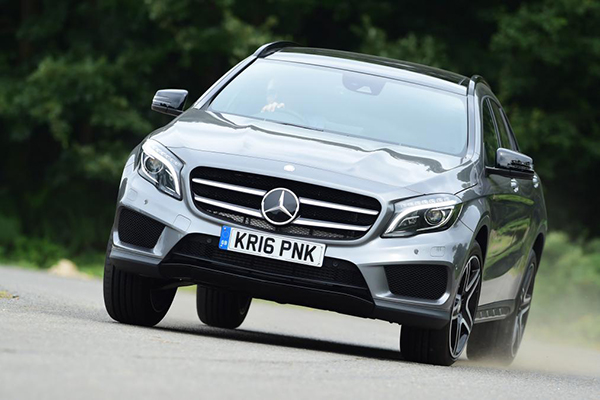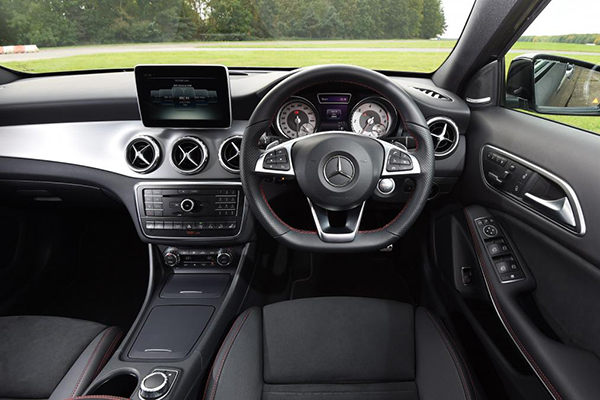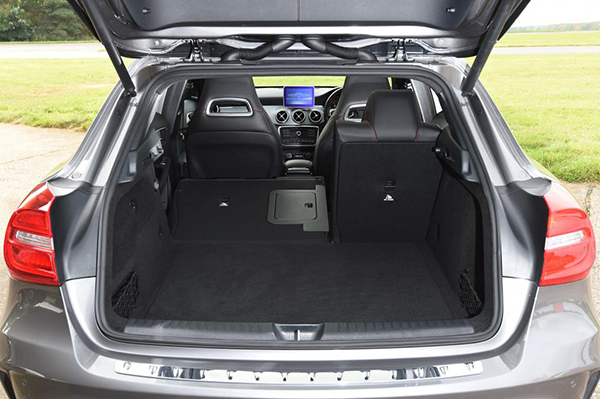The Mercedes GLA is essentially an A-Class with more rugged styling, a raised ride height and a higher driving position. That lets it target the seriously lucrative premium crossover segment, although other cars of this type – like the BMW X1 or Audi Q2 – are more convincing. A range of minor updates in 2017 did little to change its position, either.

Venture up the range or start getting too familiar with the options list, and you’ll end up with something priced against far more capable machinery – although competitive finance deals make it easier to swallow.
Boot space is reasonable and cabin quality is mostly up to the expectation of the badge, yet the interior is smaller than most rivals, and it falls short when it comes to standard equipment. The driving experience is nothing to write home about, either.

Our Choice
Mercedes GLA 250 4MATIC AMG Line Edition
The Mercedes GLA is a small crossover that’s more of an extension of the A-Class hatchback (albeit the previous generation model) than a proper small off-roader. It’s been for sale since 2014, so it’s one of the earlier examples of the breed, and also means it’s more of a high-riding hatch than some rivals.
The range has been streamlined prior to the launch of the all-new model, due in spring 2020. Out go the diesel and hot AMG 45 versions, leaving only petrol-powered Urban Edition and AMG Line variants. The price list now includes just the GLA 180, GLA 200 and GLA 250 4MATIC.

Go for the GLA 180, and you get a 120bhp 1.6-litre turbo petrol engine with front-wheel drive and either a 6-speed manual or a 7G-DCT twin-clutch auto. The GLA 200 has the same 1.6-litre motor but tuned to make 154bhp, and it has the same option of manual or auto boxes. At the top of the range, the GLA 250 has a 2.0-litre turbo petrol engine making 208bhp with the 7G-DCT auto as standard, and it’s the only version of the GLA to come with 4MATIC four-wheel drive.
Diesel power came in the guise of the GLA 200 d and GLA 220 d models, both powered by the same 2.1-litre diesel with different power outputs. This engine was pretty old and noisy, so it’s no surprise that it was quietly dropped from the range in 2019.
All cars come well equipped, with LED headlights, an 8-inch infotainment screen, auto wipers and a reversing camera coming as standard on all models. The AMG Line gets a slightly sportier look, while both versions of the GLA can be upgraded with Plus packs that offer a host of extras bundled into one package for better value.
Since the Mercedes GLA arrived, the small premium SUV class has changed shape, and there are a lot of rivals for it that offer a more SUV-like experience. Market leaders include the Volvo XC40, the BMW X1/X2 duo and the Audi Q2. Elsewhere, buyers might like to choose slightly larger cars such as the Range Rover Evoque, while the Lexus UX and Mazda CX-3 are also contenders in the class.

As it rides 50mm higher, has fatter tyres and softer suspension than the previous generation Mercedes A-Class hatchback on which it’s based, the GLA is a more comfortable car. There is a slight trade-off in terms of handling compared to the lower, firmer and 40kg lighter A-Class, but it’s a price well worth paying for the improved ride quality.
That’s not to say the GLA is a mess in the corners. While a BMW X1 is sharper from behind the wheel, the Mercedes gets close to rivals like the Audi Q3 for handling. However, both competitors still offer a more composed and refined ride.
What can make a difference here is the 4MATIC all-wheel-drive system. When connected to the seven-speed automatic gearbox (manual is not an option with 4MATIC) it can send up to 50 per cent of the engine’s power to the rear wheels for extra grip whenever they need it.
As with quite a few small SUVs, the Mercedes GLA suffers from a stiff low-speed ride. Things improve the faster you’re going, but the car is still prone to crashing over bumps and potholes – if not quite as badly as the A-Class hatchback.
Our other complaint with the driving experience is the unnatural way in which the variable power-assisted steering suddenly becomes heavier as you apply more lock in tighter turns. The inert and slow steering means it’s not the most involving car to drive on twisty roads – and it’s cumbersome around town and in tight car parks as well – but at least body control is quite good.

Engines
As of 2019, the GLA only came with petrol power, and the only version of these we’ve tried is the GLA 250. It uses a refined 2.0-litre petrol engine, and with 208bhp and standard-fit 4MATIC four-wheel drive, it can go from 0-62mph in 6.6 seconds.
Of the now-discontinued diesels, the 134bhp GLA 200 d gives decent performance, with 0-62mph in 9.5 seconds. The 2.1-litre diesel is one of the larger units in the class, but it clatters noisily at idle, sending vibrations through the car’s floor. On the motorway, it settles down to a background hum, but becomes more intrusive as you work it harder.
Yet what the 200 d lacks in refinement, it makes up for with performance. With 134bhp on tap, the GLA is 30bhp more powerful than a Mazda CX-3 with the 1.5D. When we tested a GLA 200 d, we recorded a 0-60mph time of 9.3 seconds. It also led the way during our in-gear tests, proving significantly faster than a CX-3 and Audi Q2 1.6 TDI from 30-50mph and 50-70mph.

However, on the road, the GLA never feels as fast as these figures suggest, because in default ECO mode, the gearbox shifts up early and throttle response is tardy. Sport mode is available, but this hangs on to the gears for longer, which results in much noisier progress. You can shift gears manually using the steering wheel-mounted paddles, but the gearshifts are ponderous for a twin-clutch unit.
The same 2.1-litre engine is also used in the 220 d, but here it has 175bhp so it’s noticeably quicker; just not quite as economical and certainly no more refined: anything other than gentle acceleration brings with it a coarse, loud rattle, and this doesn’t really improve once the engine has warmed up.
With a range of petrol engines being the only ones on offer until spring 2020, the Mercedes GLA has to give second best to its rivals for fuel efficiency. Under the latest WLTP test procedure, the GLA 180 manages up to 40.4mpg with the manual gearbox, while the auto-equipped version manages up to 39.2mpg. Go for the GLA 200, and these figures are 39.8mpg and 38.2mpg respectively. Move up to the 2.0-litre turbo petrol GLA 250, and it manages up to 35.8mpg, as it’s pegged back by its standard-fit 4MATIC four-wheel drive and auto gearbox.

The best performing GLA models for fuel economy were the diesels. Whether you go for a manual or automatic gearbox, the front-wheel-drive Mercedes GLA 200 d is a cheap car to run, with a claimed 46.3mpg under the WLTP tests, while CO2 emissions stand at around 150g/km irrespective of whether you go for an automatic or manual.
The GLA 220 d features a more powerful version of the same engine, with 175bhp, but still shouldn’t break the bank when it comes to running costs. The official economy figure is quoted at 47.9mpg for the standard car and 47.1 for the AMG Line, although these figures are the older NEDC rates, and you’re more likely to achieve the claimed WLTP figures in the GLA 200 d in the real world.

Insurance groups
Insurance is another area in which the Mercedes is potentially going to be more expensive than its key competitors.
You’re looking at groups 22 and 23 for the GLA 180 and 200 models, while the GLA 250 sits in groups 28-30, depending on specification. However, entry-level versions of the Audi Q3 and BMW X1 start lower in the 20s and, with the exception of the flagship Audi RS Q3, neither rival exceeds insurance group 30, regardless of the model.

Depreciation
Mercedes has put a lot of work into improving its residual values lately, and small SUVs with premium badges are known for holding their money well, so the GLA will be less prone to depreciation than rivals.
Unlike its tall, SUV-inspired rivals, the Mercedes GLA looks like a family hatchback on stilts – and that’s exactly what it is. While the large headlamps, bold grille and curved roofline are reminiscent of the A-Class hatchback.
There are a few rugged elements to the GLA, such as the plastic body cladding and wheelarches, which mark it out as an SUV. The Urban Edition model comes with 18-inch 5-twin-spoke alloy wheels, LED high performance headlamps and Night package gloss black trim with aluminum roof rails, while AMG Line versions feature 19-inch alloys, AMG bodystyling and ARTICO man-made leather-trimmed sports seats.
The GLA’s interior follows on from the A-Class, as the dash has been inspired by the company’s old SLS AMG supercar. It features racy-looking dials and a tablet-style display for the infotainment system, which features on other Mercedes models.
The large bezel design on this screen is now starting to look a little dated, but the interior is all solidly screwed together. Generally speaking, plenty of high-grade materials are used, although some of the plastics lower down on the dashboard look and feel a little low-rent.
The downside is that unlike in other compact SUVs, you don’t sit particularly high in the GLA due to its low-slung stance. The narrow windscreen and thick A-pillars mean occupants feel a little hemmed in, just as they do in the A-Class.

Sat-nav, stereo and infotainment
A larger eight-inch screen is standard across the range. Apple CarPlay and Android Auto come as standard, and both are easy to access via the system’s clearly laid out menus and neat graphics. A simplified version of the brand’s COMAND rotary controller is located on the transmission tunnel and it’s fairly simple to use.
Sat-nav is available on AMG Line variants, but all models feature a six-speaker audio system, Bluetooth and 2 USB ports.
As the Mercedes GLA SUV is based on the previous generation A-Class hatchback, it carries over that car’s reasonable level of practicality – in the front of the cabin, at least. There are plenty of cubbyholes dotted around the interior and decent-sized door bins, while a large rear window and the elevated driving position improve visibility over the A-Class. The GLA is a five-seater only, as seven-seat layouts are reserved for larger SUVs in the Mercedes range, such as the GLS.

Size
The GLA is quite a long car, measuring 4,417mm long by 1,804mm wide. That makes it longer than the Audi Q3 and the Range Rover Evoque, but slightly shorter than the BMW X1. However, the Mercedes’ low-slung stance – it’s only 1,494mm tall – and the fact that it’s based on a hatchback mean you don’t sit as high up as you do in any of its chief rivals, so the view out of the cabin isn’t as good.
Leg room, head room & passenger space
Even though it’s one of the longer cars in its class, the GLA is quite tight for space inside. That lower roofline impedes room slightly, particularly for passengers in the back.
Equally, the combination of small side windows and dark trim makes the cabin feel claustrophobic, while the front seat runners are too close together, which reduces foot space for those in the rear.

Boot
The 481-litre boot in the GLA is 61 litres bigger than those in the Audi Q3 and the Range Rover Evoque, although it’s a little shy of the 505 litres in the BMW X1. Fold the Mercedes’ rear seats down flat and you end up with 1,235 litres of space, which is less than the maximum boot capacity in its three main rivals, so that’s worth considering if you regularly transport big loads.
After a dip in quality in the nineties and early noughties, Mercedes once again produces some of the most reliable cars you can buy.
That being said, in our latest Driver Power satisfaction survey, Mercedes ranked in the lower half of the manufacturer poll, which isn’t particularly indicative of a highly reliable marque, with owners reporting more issues with faults than rival brands Audi and BMW. The GLA itself hasn’t appeared in our Driver Power satisfaction survey, so we will have to wait to review the car on an individual basis.

In terms of safety, Mercedes has always set a high standard, as many of the features of its flagship luxury saloon, the S-Class, make their way down to the lesser models in the range.
All versions of the GLA come with Pre-Safe, which prepares you and the car for an impending accident; Attention Assist sounds a warning if the driver looks as though they’re about to nod off; and Collision Prevention Assist automatically applies the brakes if it detects an impending front-end collision.
Plenty of other hi-tech safety kit is also available, although it does push up the price of the car if you specify several as options. The result is a full five-star Euro NCAP crash test rating, awarded in 2014.

Warranty
Mercedes’ warranty is a three-year/unlimited-mileage package. This is identical to the package supplied with Land Rover and BMW models, but goes one better than the Audi warranty, which limits cover to three years and 60,000 miles.
Servicing
Buyers are offered a service plan based on mileage that Mercedes tailors for each car. For GLA owners covering up to 15,500 miles a year, the payment for the service plan starts at around £27 a month, which gets you one annual service and runs up to three years. By increasing the monthly cost, it’s possible to have more services in a shorter space of time and account for higher mileages.
2020 Mercedes-Benz GLA Pre-Facelift Review & Test Drive
18/02/2020
2 Comments
Mercedes-Benz | Mercedes-AMG
Click to rate this post
[Total: 1 Average: 5]
Phillipjes
Главная [url=https://doddep-vodka.com]vodkabet[/url]